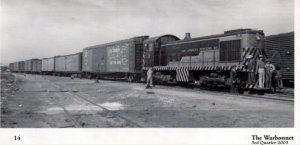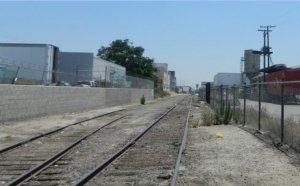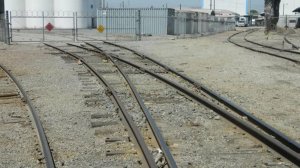You are using an out of date browser. It may not display this or other websites correctly.
You should upgrade or use an alternative browser.
You should upgrade or use an alternative browser.
HO ballast
- Thread starter BigE
- Start date
BigE
Active Member
I remember that from along time ago and it was suggested not to do this because it gives a "salt and pepper" look. I've never tried it but I have seen pictures of it done. Edit: it may work with fine but not sure.
I agree and that makes sense to me. He didn't say whether or not he did any further weathering.
So, you would vote for all gray then?
E.
goscrewyourselves
I'm the one
E,
I tried that on a small section of my track and it looked like the proverbial. I didn't like the look at all. If you want a "dirty look" your probably better off using a grey ballast then using a darker grey or black powder sprinkled over it. Not sure if that would work either but I'd test it on some spare track before I did it.
I tried that on a small section of my track and it looked like the proverbial. I didn't like the look at all. If you want a "dirty look" your probably better off using a grey ballast then using a darker grey or black powder sprinkled over it. Not sure if that would work either but I'd test it on some spare track before I did it.
D&J RailRoad
Professor of HO
If ya want a dirty look, finish the ballast work first then do a light ink wash over it.
BigE
If you're modeling a prototype RR go look at their tracks or find pix &/or written descriptions. But most RRs used ballast from their own source so it was always a uniform color. But if a source of ballast dried up they'd get it from another source. If it was a different color, it didn't matter. It would be put on top of the old ballast. If there's prototype salt & pepper ballast out there it must have come from the same source. Early on Santa Fe used to a gray ballast in SoCal but in later years it became a light mauve color from Newberry CA (east of Barstow).
If you're modeling a prototype RR go look at their tracks or find pix &/or written descriptions. But most RRs used ballast from their own source so it was always a uniform color. But if a source of ballast dried up they'd get it from another source. If it was a different color, it didn't matter. It would be put on top of the old ballast. If there's prototype salt & pepper ballast out there it must have come from the same source. Early on Santa Fe used to a gray ballast in SoCal but in later years it became a light mauve color from Newberry CA (east of Barstow).
What I did was go to this site
http://www.rrscenery.com/
and looked at their offerings.
Then I ordered a half dozen of the ones I liked. I cut a 3" wide piece of the 2" thick rigid foam that I use as a sub-roadbed. I installed my usual roadbed (Woodland Scenics foam) and a piece of HO scale Peco flex track.
Then I ballasted 6" long stretches using each different ballast I ordered.
Over a period of several days I would look at the results and eventually settled on one.
Good luck.
http://www.rrscenery.com/
and looked at their offerings.
Then I ordered a half dozen of the ones I liked. I cut a 3" wide piece of the 2" thick rigid foam that I use as a sub-roadbed. I installed my usual roadbed (Woodland Scenics foam) and a piece of HO scale Peco flex track.
Then I ballasted 6" long stretches using each different ballast I ordered.
Over a period of several days I would look at the results and eventually settled on one.
Good luck.
logandsawman
Well-Known Member
Go look at real tracks. You will see the ballast is all the same color.
This must depend on where you live. Or, the source of the ballast. Ours is a combination of grays, browns, and black. I have seen the monocolor stuff, too.
The advice about looking at the track you are modelling is probally sure fire.
marriedshades
Member
I can see using black around coal mines and oiltanks. But other than that brown would make more sence.
The only constant in this word is "Change', especially thru time. That can occur thru mergers, abandonment, different ballast sources, etc., etc., etc. All prototype modelers can do is follow theirs as best they can & don't worry about nit pickers. If your MR a freelance, don't worry about it because it's yours !!!! And if you already have different color ballast use them & make up what ever reasons you want. On my Los Angeles Junction Ry layout don't have to use much any way because their ballast looks like it was added later as an afterthought. And the max. authorized speed is only 10 mph. See the LAJ "ballast" below.








photoman475
Member
I model the anthracite area of Pennsylvania in the 1960s-1970s. The salt and pepper look is appropriate for my area since coal being dropped out of cars from ill fitting doors on hoppers, derailments, bad track, etc., had to go someplace. I mix gray HO medium with N black fine ballast to simulate the coal. I have varied the amount of black ballast depending on the section. The track closest to the coal mine has or will have more than areas further away from the mine.
It all depends on what you're modeling.
It all depends on what you're modeling.
Most HO medium ballast is about 5"-6" where as real scale ballast is in the 3-4" size. So alot of HO modelers use N scale And coal sizes can be anywhere from fines to 6"+ depending on what the consumer needs. Since your MR is based on the Pennsy, can you go there or if not look at pix to see the ballast & coal sizes? That info might also be found in the historical society websites.
Greg@mnrr
Section Hand
BigE:
I like using "Fine" ballast from Woodland scenic's for my layout. I believe that fine is more to scale than medium or large ballast in at least HO..
I also do a blend since if you walk a railroad right of way, the real ballast is a mix of colors and color patterns. I use a mixture of Brown 70%, Gray 15% and Black 15% on my mainline. This mix avoids a salt and pepper look. I keep the blended ballast in a large metal coffee can between use.
A branch line on my layout has brown ballast mixed with real sand from Sedona, Arizona for a real branch line feel. I areas I cover the ties and add a small amount of ground foam for weeds.
Whatever mixture you use, keep a record of the mix ratios used for future reference.
Once the ballast is glued in place I add "oil" in the middle of the rails using either diluted grimy black or India ink.
Don't be afraid to add spots of "repaired" ballast using a slightly different blend in areas.
Thanks.
Greg
I like using "Fine" ballast from Woodland scenic's for my layout. I believe that fine is more to scale than medium or large ballast in at least HO..
I also do a blend since if you walk a railroad right of way, the real ballast is a mix of colors and color patterns. I use a mixture of Brown 70%, Gray 15% and Black 15% on my mainline. This mix avoids a salt and pepper look. I keep the blended ballast in a large metal coffee can between use.
A branch line on my layout has brown ballast mixed with real sand from Sedona, Arizona for a real branch line feel. I areas I cover the ties and add a small amount of ground foam for weeds.
Whatever mixture you use, keep a record of the mix ratios used for future reference.
Once the ballast is glued in place I add "oil" in the middle of the rails using either diluted grimy black or India ink.
Don't be afraid to add spots of "repaired" ballast using a slightly different blend in areas.
Thanks.
Greg
You can find "salt and pepper" ballast, mostly where they ballasted with one color from one pit and then reballasted from another pit.
Commonly ballast is some shade of grey (from a dark grey to a blue grey to near white), or pink (red/pink granite) or a dark brown color (dark rock or slag).
The color also depends on the era. Older roads used seashells or oyster shells or whatever the local rock was on the main and cinders for the subroadbed or yards. Cinders were usually a darker color, blackish to grey. Modern roads use ballast for everything, they just use different sizes of ballast, really big on concrete ties, big on mains, smaller in yards and chat on walkways.
Dirty ballast was the color of, well dirt. I mix a little of the latex paint I use for the dirt color into my glue mix I dribble over the ballast. Just enough to give a hint of color. That adds a dirty dusty effect to the ballast and unifies the colors.
Commonly ballast is some shade of grey (from a dark grey to a blue grey to near white), or pink (red/pink granite) or a dark brown color (dark rock or slag).
The color also depends on the era. Older roads used seashells or oyster shells or whatever the local rock was on the main and cinders for the subroadbed or yards. Cinders were usually a darker color, blackish to grey. Modern roads use ballast for everything, they just use different sizes of ballast, really big on concrete ties, big on mains, smaller in yards and chat on walkways.
Dirty ballast was the color of, well dirt. I mix a little of the latex paint I use for the dirt color into my glue mix I dribble over the ballast. Just enough to give a hint of color. That adds a dirty dusty effect to the ballast and unifies the colors.
I spent my first 14 years living literally next to the Sante Fe mainline in Los Angeles. The balast was "manicured" every three months or so. Generally it was grey and dark grey however what I remember most from walking those rails nearly daily was the high percentage of glass that was included. I was literally a hazard when walking the tracks. I've often wonder how that could be modeled. The SP rails a few blocks away used a very light grey ballast with almost no glass in it, weird huh?
A2TwrOpr
Member
I used a mix of n scale (fine) ballast with medium (ho scale) ballast. It's all the same color but the different size rocks give it a little more realism. Just take a bag of each and throw them into a container and stir it up then lay it down. As far as using black to get a weathered look, it does not appeal to me. If you want a weathered look then just go in and weather it all once the ballast is laid.

